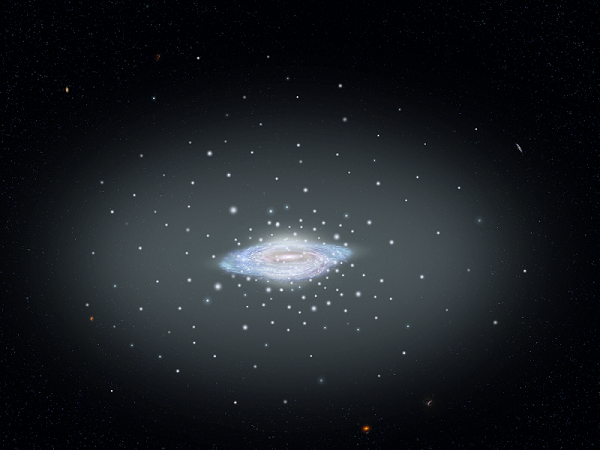Astronomers have arrived at a new, precise measurement of the mass of the Milky Way. Historical estimates have varied widely, from 500 billion times the mass of the Sun—a quantity known as a solar mass—to as high as three trillion solar masses. The new figure, which combines observations from NASA's Hubble Space Telescope and the European Space Agency's Gaia spacecraft, winnows this estimate closer to 1.5 trillion solar masses. Accurately accounting for the amount of mass in the Milky Way is an important step in building ever-more powerful models of galaxy formation and evolution on vast cosmological scales. Literally closer to home, the improved measurement aids in tracing the history of the single galaxy we are uniquely positioned to study from the inside-out. See also: Cosmology; Galaxy; Gaia mission; Hubble Space Telescope; Mass; Milky Way Galaxy; Sun

To make the new Milky Way mass estimate, astronomers used Hubble and Gaia to observe dense collections of stars known as globular clusters. The movement of globular clusters in and around a galaxy, due to gravity, is tied to the mass of that galaxy. Mass warps the spacetime fabric of the universe, manifesting as gravitational attraction. Previous measurements to globular clusters in this manner had only been line-of-sight, measuring whether clusters were approaching or receding. The Hubble and Gaia data are three-dimensional, however, tracking lateral motions of globular clusters. This enhanced spatial resolution delivers more accurate readings of gravity-induced accelerations. See also: Acceleration; Globular clusters; Gravity; Spacetime; Star
For its part in the investigation, Gaia gauged 34 globular clusters out to 65,000 light-years. The Hubble observations looked farther out—to 130,000 light-years—encompassing a dozen globular clusters. Pooling the results allowed for researchers to extrapolate mass distribution to distances nearly a million light-years from Earth, out into the galactic halo and well past the more familiar disk of spiral arms, which span about 100,000 light-years. See also: Earth; Light-year
KAll told, the Milky Way weighs in as a heavier- and bigger-than-average galaxy, but it still falls well within galactic norms. The galaxy hosts around 200 billion stars. Its single most massive object, located at the galactic center, is a supermassive black hole containing the equivalent mass of four million Suns. Yet these astrophysical objects constitute only a small portion of total galactic mass. Most of the Milky Way's mass—as well as the universe's—is contained within a mysterious substance known as dark matter. This material's presence is inferred through multiple, corroborating lines of evidence, including the relic radiation of the big bang (known as the cosmic microwave background) and how stars stay within their galaxies, despite moving at speeds that should fling them out into space. In the Milky Way's case, globular clusters' motions helped pin down this unseen, yet dominant dark-matter component. Continuing progress in studying dark-matter distribution in galaxies and across the cosmos should help refine our understanding about the universe's evolution over its 13.8-billion-year history and into the future. See also: Big bang theory; Black hole; Cosmic background radiation; Dark matter; Matter (physics)





